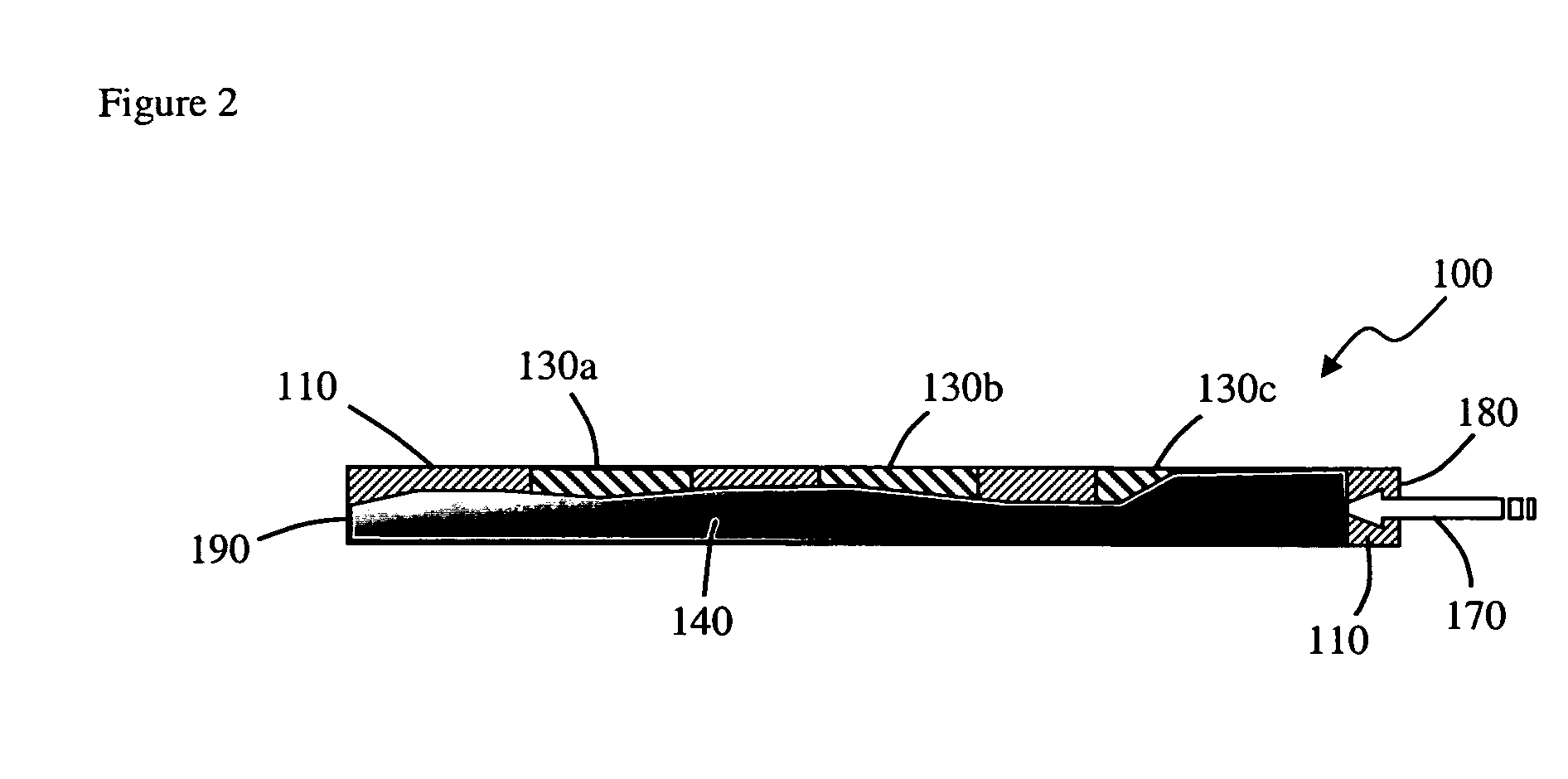Lateral flow assay devices and methods of use
a technology of lateral flow and assay device, which is applied in the field of fluid analysis, can solve the problems of not being able to be integrated into the new rapid immunoassay test device, and achieve the effects of inhibiting backflow, promoting an even development of detectable signals, and inhibiting backflow
- Summary
- Abstract
- Description
- Claims
- Application Information
AI Technical Summary
Benefits of technology
Problems solved by technology
Method used
Image
Examples
example 1
Construction of Test Strips
[0043] Test strips were constructed as sheets containing multiple test strips, which were later cut to produce individual test strips. A completed sheet was constructed by placing a 10.16 cm×27.94 cm pressure-sensitive adhesive backing card on a lab bench with the adhesive side up. The protective paper was peeled from the card, to expose the adhesive. A polyamide fibrous absorbent material of the same dimensions (Filtrona Fibertec™) was placed on top of the adhesive backing card. Three narrow strips of water-insoluble adhesive of dimensions about 0.2×27.9 cm (AS-110 acrylic medical grade adhesive) were laid down at regularly spaced intervals of 0.5 to 0.8 cm. Fiberglass strips of about 0.5 cm×27.9 cm were laid on top of the adhesive and the absorbent material, such that about 0.25 cm of the fiberglass overlapped the adhesive and 0.25 cm of the fiberglass was in direct contact with the absorbent material. Next, 0.5 cm×27.9 cm 3MM paper reagent pad strips w...
example 2
Urine Testing for Adulteration
[0044] 5 ml aliquot test solutions were prepared according to the following methods.
[0045] Creatinine Urine Analysis: Pooled urine having an initial creatinine concentration of 140 mg / dl was diluted with deionized water to give creatinine concentrations of 10 mg / dl, 20 mg / dl, 50 mg / dl and 100 mg / dl.
[0046] Nitrite Urine Analysis: Four 5 ml aliquots of nitrite-negative pooled urine were spiked with nitrite to give final concentrations of 0 mg / dl, 20 mg / dl, 50 mg / dl and 100 mg / dl.
[0047] Glutaraldehyde Urine Analysis: Glutaraldehyde-negative pooled urine aliquots were spiked with glutaraldehyde to give the following concentrations: 50 mg / dl, 100 mg / dl, 500 mg / dl and 2000 mg / dl glutaraldehyde.
[0048] Three test lots of strips were made, as described above in Example 1. Tests were conducted on three separate days, using 5 strips from each lot of strips with each concentration of adulterant. Thus, each concentration of adulterant (creatinine, nitrite or gl...
example 3
Obstetrician's Office
[0052] This example illustrates the use of an embodiment of the invention for medical screening during pregnancy. In the medical office, a test strip is utilized that has reagent pads for the testing of sugar, protein, creatinine, blood, and pH. The test strip is dipped into a sample of urine from a pregnant patient. The urine wicks to the second end 190 of the test strip. The assay result is compared with a standard chart. If the assay indicates an abnormal result for any of the test included in the test strip, further testing and / or evaluation can be ordered.
PUM
 Login to View More
Login to View More Abstract
Description
Claims
Application Information
 Login to View More
Login to View More - R&D
- Intellectual Property
- Life Sciences
- Materials
- Tech Scout
- Unparalleled Data Quality
- Higher Quality Content
- 60% Fewer Hallucinations
Browse by: Latest US Patents, China's latest patents, Technical Efficacy Thesaurus, Application Domain, Technology Topic, Popular Technical Reports.
© 2025 PatSnap. All rights reserved.Legal|Privacy policy|Modern Slavery Act Transparency Statement|Sitemap|About US| Contact US: help@patsnap.com



